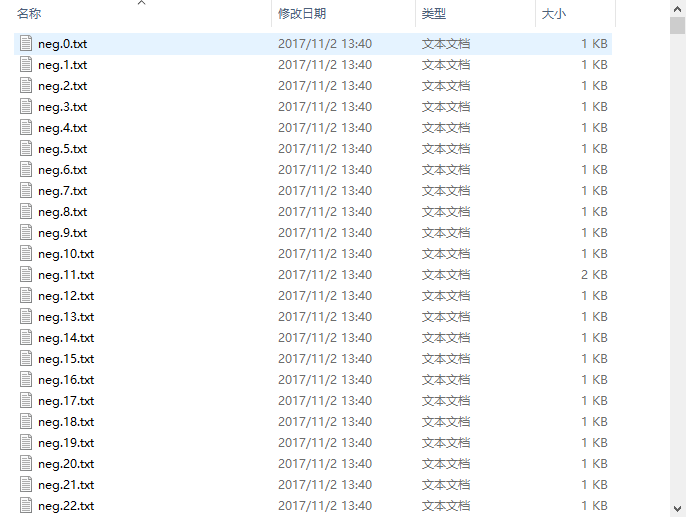数据集:ChnSentiCorp-Htl-ba-4000

由于该数据集中的文件是分散的(一句评论一个文件),这样处理起来会比较麻烦,所以我们先要对它们进行合并:
# 这个步骤建议在本地完成,因为colab读取大量零散的google drive文件的速度非常慢
from tqdm import tqdm
def combine_files(data_label, dir_path):
data_files = os.listdir(dir_path)
data_collection = []
for data_file in tqdm(data_files):
with open(dir_path + '//' + data_file, "r", encoding='utf-8') as file_pipeline:
data = file_pipeline.read()
data_collection.append(data)
with open(data_label + '.pickle', 'rb') as file_pipeline:
pickle.dump(data_collection, file_pipeline)
接下来,我们进行数据预处理,这里包含了字符过滤,去停用词,分词等三个步骤:
这里使用的停用词表为:四川大学机器智能实验室停用词库 scu_stopwords.txt
# 注意neg.1156.txt中的评论内容过少,经停用词处理后得到空字符串
import os
import re
import pickle
import jieba
from tqdm import tqdm
DATA_DIR = "/content/drive/Shared drives/A/data/ChnSentiCorp/ChnSentiCorp-Htl-ba-4000/"
NEG_DATA_DIR = DATA_DIR + "neg.pickle"
POS_DATA_DIR = DATA_DIR + "pos.pickle"
STOPWORDS_PATH = "/content/drive/Shared drives/A/data/stopwords/scu_stopwords.txt"
# 只保留中文字符
def clean_data(data):
data = data.replace('\n', '')
data = re.sub(r'[a-zA-Z0-9]', '', data)
data = re.sub(r"[\s+\.\!\/_,$%^*(+\"\']+|[+—!,。??;;、~@#¥%…&*()]+", "", data)
return data
# 分词
def cut_sentence(data, stopwords):
word_list = jieba.cut(data)
result = []
for word in word_list:
if word not in stopwords:
result.append(word)
return ' '.join(result).strip()
# 去除停用词
def get_stopwords(stopwords_path):
with open(stopwords_path, 'r', encoding='utf8') as file_pipeline:
data = file_pipeline.read()
data = set(data.strip().split('\n'))
return data
# 读取并处理数据
def process_data(data_path, stopwords):
data_collection = []
with open(data_path, 'rb') as file_pipeline:
contents = pickle.load(file_pipeline)
for index, content in tqdm(enumerate(contents)):
data = clean_data(content)
data = cut_sentence(data, stopwords)
data_collection.append(data)
return data_collection
# 分别处理正负样本,保存处理结果
stopwords = get_stopwords(STOPWORDS_PATH)
neg_data = process_data(NEG_DATA_DIR, stopwords)
pos_data = process_data(POS_DATA_DIR, stopwords)
with open(DATA_DIR + 'neg_cleaned.pickle','wb') as file_pipeline:
pickle.dump(neg_data, file_pipeline)
with open(DATA_DIR + 'pos_cleaned.pickle','wb') as file_pipeline:
pickle.dump(pos_data, file_pipeline)
接下来我们要把文本数据转化成向量数据,这里用到了上一篇博客中训练的词向量模型:
import pickle
import numpy as np
import pandas as pd
from tqdm import tqdm
from gensim.models import Word2Vec
# 把一组词转化为一组词向量
def get_word_vecs(word_list, model):
vecs = []
for word in word_list:
word = word.replace('\n', '')
try:
vecs.append(model[word])
except KeyError:
continue
return np.array(vecs, dtype='float')
# 构建句子向量
def build_vecs(data_path, model):
doc_vecs = []
with open(data_path, 'rb') as file_pipeline:
contents = pickle.load(file_pipeline)
for index, line in tqdm(enumerate(contents)):
word_list = line.split(' ')
word_vecs = get_word_vecs(word_list, model)
# 用句子中所有词向量的均值来表示这个句子
if len(word_vecs) > 0:
sentence_vec = np.mean(word_vecs, axis=0)
doc_vecs.append(sentence_vec)
return doc_vecs
# 加载预训练词向量模型
data_dir = '/content/drive/Shared drives/A/data/ChnSentiCorp/ChnSentiCorp-Htl-ba-4000/'
w2v_model_path = '/content/drive/Shared drives/A/data/pre_training/wiki_zh_w2v/wiki_zh_text_model'
w2v_model = Word2Vec.load(w2v_model_path).wv
# 数据向量化
posInput = build_vecs(data_dir + 'pos_cleaned.pickle', w2v_model)
negInput = build_vecs(data_dir + 'neg_cleaned.pickle', w2v_model)
# 数据标签:1-pos, 0-neg
Y = np.concatenate((np.ones(len(posInput)), np.zeros(len(negInput))))
X = np.array(posInput + negInput)
# 保存结果
df_x = pd.DataFrame(X)
df_y = pd.DataFrame(Y)
result = pd.concat([df_y,df_x],axis = 1)
print(result)
result.to_csv(data_dir + 'vec_data.csv')
最后是降维与分类:
# 降维与分类
import numpy as np
import pandas as pd
import matplotlib.pyplot as plt
from sklearn.decomposition import PCA
from sklearn import svm, metrics
from sklearn.model_selection import GridSearchCV, train_test_split
data_dir = '/content/drive/Shared drives/A/data/ChnSentiCorp/ChnSentiCorp-Htl-ba-4000/'
# 读取数据
df = pd.read_csv(data_dir + 'vec_data.csv')
y = df.iloc[:,1]
x = df.iloc[:,2:]
# 分析降维范围
n_components = 400
pca = PCA(n_components=n_components)
pca.fit(x)
plt.figure(1, figsize=(4, 3))
plt.clf()
plt.axes([.2, .2, .7, .7])
plt.plot(pca.explained_variance_, linewidth=2)
plt.axis('tight')
plt.xlabel('n_components')
plt.ylabel('explained_variance_')
plt.show()
# 降维
x_pca = PCA(n_components = 100).fit_transform(x)
# 将数据划分为训练集和测试集,test_size=.2表示20%的测试集
x_train, x_test, y_train, y_test = train_test_split(x_pca, y, test_size=.2)
# svm分类并测试
svc = svm.SVC(kernel='rbf', class_weight='balanced',)
c_range = np.logspace(-5, 15, 11, base=2)
gamma_range = np.logspace(-9, 3, 13, base=2)
# 网格搜索交叉验证的参数范围,cv=3,3折交叉
param_grid = [{'kernel': ['rbf'], 'C': c_range, 'gamma': gamma_range}]
grid = GridSearchCV(svc, param_grid, cv=3, n_jobs=-1)
# 训练模型
clf = grid.fit(x_train, y_train)
# 计算测试集精度
score = grid.score(x_test, y_test)
print('精度为%s' % score)

通过由pca.explained_variance_绘制出的图像可以看出,前100维的向量已经具备较高的区分能力,因此我们把400维的词向量压缩至100维,然后喂入svm进行训练,最后得到的精度为:88.1%